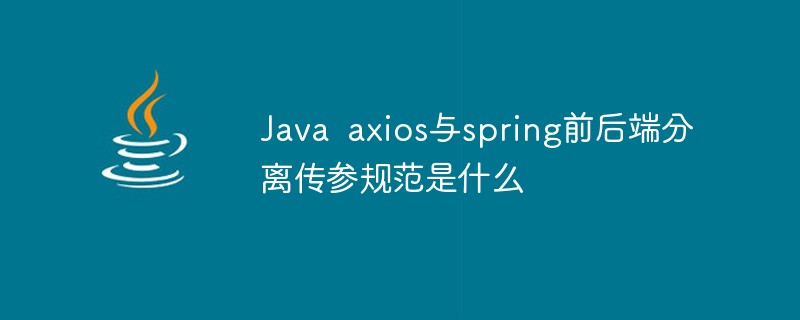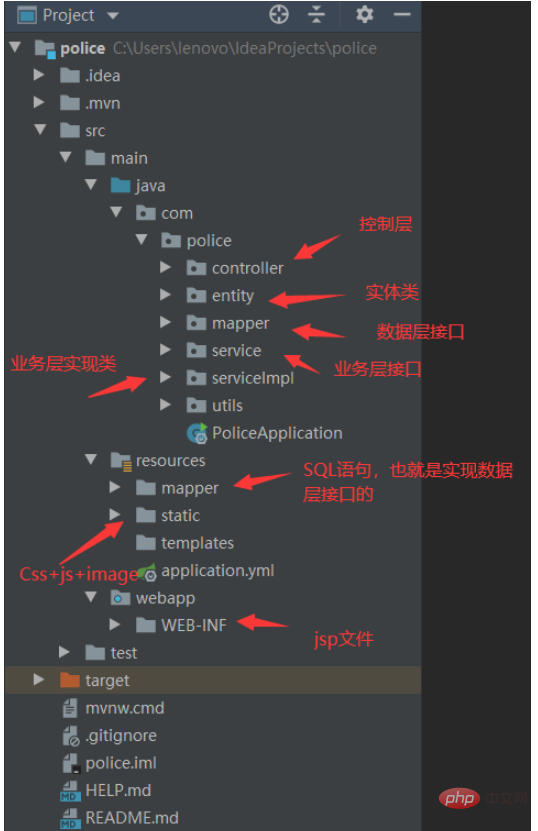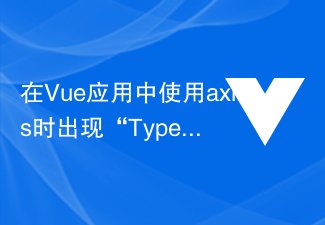這次帶給大家vue axios呼叫介面時請求超時,處理vue axios呼叫介面時請求超時的注意事項有哪些,以下就是實戰案例,一起來看一下。
自從使用Vue2之後,就使用官方推薦的axios的插件來調用API,在使用過程中,如果服務器或者網絡不穩定掉包了, 你們該如何處理呢? 下面我給你們分享一下我的經歷。
具體原因
最近公司在做一個專案, 服務端資料介面用的是Php輸出的API, 有時候在呼叫的過程中會失敗, 在Google瀏覽器裡邊顯示Provisional headers are shown。

按照搜尋引擎給出來的解決方案,解決不了我的問題.
最近在研究AOP這個開發程式設計的概念,axios開發說明裡邊提到的欄位器(axios.Interceptors)應該是這個機制,降低程式碼耦合度,提高程式的可重複使用性,同時提高了開發的效率。
帶坑的解決方案一
我的經驗有限,覺得唯一能做的,就是axios請求超時之後做一個重新請求。透過研究axios的使用說明,為它設定一個timeout = 6000
axios.defaults.timeout = 6000;
然後加一個欄位截取器.
// Add a request interceptor
axios.interceptors.request.use(function (config) {
// Do something before request is sent
return config;
}, function (error) {
// Do something with request error
return Promise.reject(error);
});
// Add a response interceptor
axios.interceptors.response.use(function (response) {
// Do something with response data
return response;
}, function (error) {
// Do something with response error
return Promise.reject(error);
});
這個欄位器作用是如果在請求逾時之後,欄位截器可以捕抓到訊息,然後再進行下一步操作,也就是我想要用重新請求。
這裡是相關的頁面資料請求。
this.$axios.get(url, {params:{load:'noload'}}).then(function (response) {
//dosomething();
}).catch(error => {
//超时之后在这里捕抓错误信息.
if (error.response) {
console.log('error.response')
console.log(error.response);
} else if (error.request) {
console.log(error.request)
console.log('error.request')
if(error.request.readyState == 4 && error.request.status == 0){
//我在这里重新请求
}
} else {
console.log('Error', error.message);
}
console.log(error.config);
});
逾時之後, 報出 Uncaught (in promise) Error: timeout of xxx ms exceeded的錯誤。

在catch那裡,它回傳的是error.request錯誤,所以就在這裡做retry的功能, 經過測試是可以實現重新請求的功功能, 雖然能夠實現超時重新請求的功能,但很麻煩,需要每一個請API的頁面裡邊要設定重新請求。

看上面,我這個專案有幾十個.vue 文件,如果每個頁面都要去設定超時重新請求的功能,那我要瘋掉的.
而且這個機制還有一個嚴重的bug,就是被要求的連結失效或其他原因造成無法正常存取的時候,這個機制失效了,它不會等待我設定的6秒,而且一直在刷,一秒種請求幾十次,很容易就把伺服器搞垮了,請看下圖, 一眨眼的功能,它就請求了146次。

帶坑的解二
#研究了axios的原始碼,逾時後, 會在攔截器那裡axios.interceptors.response 捕抓到錯誤訊息, 且error.code = "ECONNABORTED",具體連結
https://github.com/axios/axios/blob/26b06391f831ef98606ec0ed406d2be174 adapters/xhr.js#L95-L101
// Handle timeout
request.ontimeout = function handleTimeout() {
reject(createError('timeout of ' + config.timeout + 'ms exceeded', config, 'ECONNABORTED',
request));
// Clean up request
request = null;
};
所以,我的全域逾時重新取得的解決方案這樣的。
axios.interceptors.response.use(function(response){
....
}, function(error){
var originalRequest = error.config;
if(error.code == 'ECONNABORTED' && error.message.indexOf('timeout')!=-1 && !originalRequest._retry){
originalRequest._retry = true
return axios.request(originalRequest);
}
});
這個方法,也可以實現得新請求,但有兩個問題,1是它只重新請求1次,如果再超時的話,它就停止了,不會再請求。第2個問題是,我在每個有資料請求的頁面那裡,做了許多操作,例如 this.$axios.get(url).then之後操作。
完美的解決方法
以AOP程式設計方式,我需要的是一個超時重新請求的全域功能, 要在axios.Interceptors下功夫,在github的axios的issue找了別人的一些解決方法,終於找到了一個完美解決方案,就是下面這個。
https://github.com/axios/axios/issues/164#issuecomment-327837467
//在main.js设置全局的请求次数,请求的间隙
axios.defaults.retry = 4;
axios.defaults.retryDelay = 1000;
axios.interceptors.response.use(undefined, function axiosRetryInterceptor(err) {
var config = err.config;
// If config does not exist or the retry option is not set, reject
if(!config || !config.retry) return Promise.reject(err);
// Set the variable for keeping track of the retry count
config.__retryCount = config.__retryCount || 0;
// Check if we've maxed out the total number of retries
if(config.__retryCount >= config.retry) {
// Reject with the error
return Promise.reject(err);
}
// Increase the retry count
config.__retryCount += 1;
// Create new promise to handle exponential backoff
var backoff = new Promise(function(resolve) {
setTimeout(function() {
resolve();
}, config.retryDelay || 1);
});
// Return the promise in which recalls axios to retry the request
return backoff.then(function() {
return axios(config);
});
});
其他的那個幾十個.vue頁面的 this.$axios的get 和post 的方法根本就不需要去修改它們的程式碼。
在这个过程中,谢谢jooger给予大量的技术支持,这是他的个人信息 https://github.com/jo0ger , 谢谢。
以下是我做的一个试验。。把axios.defaults.retryDelay = 500, 请求 www.facebook.com

如有更好的建议,请告诉我,谢谢。
补充:
axios基本用法
vue更新到2.0之后,作者就宣告不再对vue-resource更新,而是推荐的axios,前一段时间用了一下,现在说一下它的基本用法。
首先就是引入axios,如果你使用es6,只需要安装axios模块之后
import axios from 'axios'; //安装方法 npm install axios //或 bower install axios
当然也可以用script引入
axios提供了一下几种请求方式
axios.request(config) axios.get(url[, config]) axios.delete(url[, config]) axios.head(url[, config]) axios.post(url[, data[, config]]) axios.put(url[, data[, config]]) axios.patch(url[, data[, config]])
这里的config是对一些基本信息的配置,比如请求头,baseURL,当然这里提供了一些比较方便配置项
//config
import Qs from 'qs'
{
//请求的接口,在请求的时候,如axios.get(url,config);这里的url会覆盖掉config中的url
url: '/user',
// 请求方法同上
method: 'get', // default
// 基础url前缀
baseURL: 'https://some-domain.com/api/',
transformRequest: [function (data) {
// 这里可以在发送请求之前对请求数据做处理,比如form-data格式化等,这里可以使用开头引入的Qs(这个模块在安装axios的时候就已经安装了,不需要另外安装)
data = Qs.stringify({});
return data;
}],
transformResponse: [function (data) {
// 这里提前处理返回的数据
return data;
}],
// 请求头信息
headers: {'X-Requested-With': 'XMLHttpRequest'},
//parameter参数
params: {
ID: 12345
},
//post参数,使用axios.post(url,{},config);如果没有额外的也必须要用一个空对象,否则会报错
data: {
firstName: 'Fred'
},
//设置超时时间
timeout: 1000,
//返回数据类型
responseType: 'json', // default
}
有了配置文件,我们就可以减少很多额外的处理代码也更优美,直接使用
axios.post(url,{},config)
.then(function(res){
console.log(res);
})
.catch(function(err){
console.log(err);
})
//axios请求返回的也是一个promise,跟踪错误只需要在最后加一个catch就可以了。
//下面是关于同时发起多个请求时的处理
axios.all([get1(), get2()])
.then(axios.spread(function (res1, res2) {
// 只有两个请求都完成才会成功,否则会被catch捕获
}));
最后还是说一下配置项,上面讲的是额外配置,如果你不想另外写也可以直接配置全局
axios.defaults.baseURL = 'https://api.example.com';
axios.defaults.headers.common['Authorization'] = AUTH_TOKEN;
axios.defaults.headers.post['Content-Type'] = 'application/x-www-form-urlencoded';
//当然还可以这么配置
var instance = axios.create({
baseURL: 'https://api.example.com'
});
相信看了本文案例你已经掌握了方法,更多精彩请关注php中文网其它相关文章!
推荐阅读:
以上是vue axios呼叫介面時請求逾時的詳細內容。更多資訊請關注PHP中文網其他相關文章!
 在Vue应用中使用axios时出现“Uncaught (in promise) Error: Request failed with status code 500”怎么办?Jun 24, 2023 pm 05:33 PM
在Vue应用中使用axios时出现“Uncaught (in promise) Error: Request failed with status code 500”怎么办?Jun 24, 2023 pm 05:33 PM在Vue应用中使用axios是十分常见的,axios是一种基于Promise的HTTP客户端,可以用于浏览器和Node.js。在开发过程中,有时会出现“Uncaught(inpromise)Error:Requestfailedwithstatuscode500”的错误提示,对于开发者来说,这个错误提示可能有些难以理解和解决。本文将会探讨这
 在Vue应用中使用axios时出现“TypeError: Failed to fetch”怎么办?Jun 24, 2023 pm 11:03 PM
在Vue应用中使用axios时出现“TypeError: Failed to fetch”怎么办?Jun 24, 2023 pm 11:03 PM最近,在使用Vue应用开发过程中,我遇到了一个常见的问题:“TypeError:Failedtofetch”错误提示。这个问题出现在使用axios进行HTTP请求时,后端服务器没有正确响应请求时发生。这种错误提示通常表明请求无法到达服务器,可能是由于网络原因或服务器未响应造成的。出现这个错误提示后,我们应该怎么办呢?以下是一些解决方法:检查网络连接由于
 在Vue应用中使用axios时出现“Error: Network Error”怎么解决?Jun 25, 2023 am 08:27 AM
在Vue应用中使用axios时出现“Error: Network Error”怎么解决?Jun 25, 2023 am 08:27 AM在Vue应用中使用axios时出现“Error:NetworkError”怎么解决?在Vue应用的开发中,我们经常会使用到axios进行API的请求或数据的获取,但是有时我们会遇到axios请求出现“Error:NetworkError”的情况,这时我们该怎么办呢?首先,需要了解“Error:NetworkError”是什么意思,它通常表示网络连
 Vue实现文件上传的完整指南(axios、element-ui)Jun 09, 2023 pm 04:12 PM
Vue实现文件上传的完整指南(axios、element-ui)Jun 09, 2023 pm 04:12 PMVue实现文件上传的完整指南(axios、element-ui)在现代Web应用程序中,文件上传已经成为一项基本的功能。无论是上传头像、图片、文档或者视频,我们都需要一个可靠的方法来将文件从用户的计算机上传到服务器中。本文将为您提供一份详细的指南,介绍如何使用Vue、axios和element-ui来实现文件上传。什么是axiosaxios是一个基于prom
 在Vue应用中使用axios时出现“Error: timeout of xxxms exceeded”怎么办?Jun 24, 2023 pm 03:27 PM
在Vue应用中使用axios时出现“Error: timeout of xxxms exceeded”怎么办?Jun 24, 2023 pm 03:27 PM在Vue应用中使用axios时出现“Error:timeoutofxxxmsexceeded”怎么办?随着互联网的快速发展,前端技术也在不断地更新迭代,Vue作为一种优秀的前端框架,近年来受到大家的欢迎。在Vue应用中,我们常常需要使用axios来进行网络请求,但是有时候会出现“Error:timeoutofxxxmsexceeded”的错误
 Java axios与spring前后端分离传参规范是什么May 03, 2023 pm 09:55 PM
Java axios与spring前后端分离传参规范是什么May 03, 2023 pm 09:55 PM一、@RequestParam注解对应的axios传参方法以下面的这段Springjava代码为例,接口使用POST协议,需要接受的参数分别是tsCode、indexCols、table。针对这个Spring的HTTP接口,axios该如何传参?有几种方法?我们来一一介绍。@PostMapping("/line")publicList
 axios和SpringBoot前端怎么调用后端接口进行数据交互May 13, 2023 am 10:34 AM
axios和SpringBoot前端怎么调用后端接口进行数据交互May 13, 2023 am 10:34 AM一、介绍一个完善的系统,前后端交互是必不可少的,这个过程可以分成下面几步:前端向后端发起请求后端接口接收前端的参数后,开始层层调用方法处理数据后端将最终数据返回给前端接口前端请求成功后,将数据渲染至界面二、项目结构前端技术:axios后端技术:SpringBoot(这个也无所谓,但是你一定要有控制层的访问路径,也就是所谓的请求地址对应的方法,可以用SSM框架,SSH框架,都可以)上面是大致的文件结构,相信大家后端的数据处理都没问题,无非就是:控制层接收前端请求,调用对应的业务层接口方法业务层实现
 在Vue应用中使用axios时出现“TypeError: bind is not a function”怎么办?Jun 25, 2023 am 08:31 AM
在Vue应用中使用axios时出现“TypeError: bind is not a function”怎么办?Jun 25, 2023 am 08:31 AM在Vue.js应用中,使用axios是非常常见的。Axios是一个强大的HTTP请求库,可以让你轻松发送异步HTTP请求。然而,在使用axios时,会遇到一些错误,其中之一就是“TypeError:bindisnotafunction”。这个错误通常是由于axios版本不兼容Vue.js的原因导致的。让我们来看一下这个错误的解决方法。首先,我们需要


熱AI工具

Undresser.AI Undress
人工智慧驅動的應用程序,用於創建逼真的裸體照片

AI Clothes Remover
用於從照片中去除衣服的線上人工智慧工具。

Undress AI Tool
免費脫衣圖片

Clothoff.io
AI脫衣器

AI Hentai Generator
免費產生 AI 無盡。

熱門文章

熱工具

SublimeText3 英文版
推薦:為Win版本,支援程式碼提示!

SecLists
SecLists是最終安全測試人員的伙伴。它是一個包含各種類型清單的集合,這些清單在安全評估過程中經常使用,而且都在一個地方。 SecLists透過方便地提供安全測試人員可能需要的所有列表,幫助提高安全測試的效率和生產力。清單類型包括使用者名稱、密碼、URL、模糊測試有效載荷、敏感資料模式、Web shell等等。測試人員只需將此儲存庫拉到新的測試機上,他就可以存取所需的每種類型的清單。

Dreamweaver Mac版
視覺化網頁開發工具

SAP NetWeaver Server Adapter for Eclipse
將Eclipse與SAP NetWeaver應用伺服器整合。

SublimeText3 Linux新版
SublimeText3 Linux最新版





